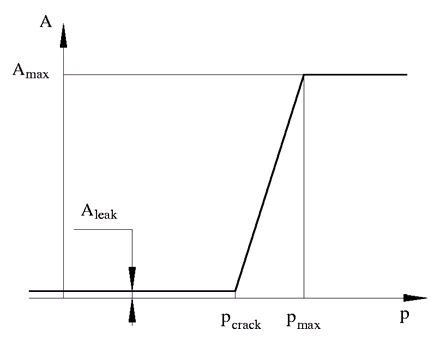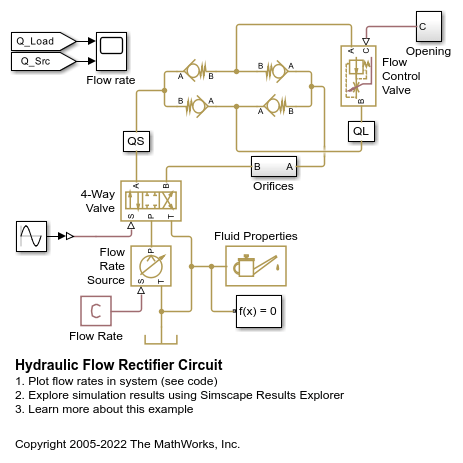Check Valve
(To be removed) Hydraulic valve that allows flow in one direction only
The Hydraulics (Isothermal) library will be removed in a future release. Use the Isothermal Liquid library instead.
For more information on updating your models, see Upgrading Hydraulic Models to Use Isothermal Liquid Blocks.
Libraries:
Simscape /
Fluids /
Hydraulics (Isothermal) /
Valves /
Directional Valves
Description
The Check Valve block represents a hydraulic check valve as a
data-sheet-based model. The check valve permits flow in one direction and blocks it in the
opposite direction. This figure shows the typical dependency between the valve passage area
A and the pressure differential across the valve .

The valve remains closed when the pressure differential across the valve is lower than the valve cracking pressure. When cracking pressure is reached, the valve control member, such as a spool or poppet, is forced off its seat, thus creating a passage between the inlet and outlet. If the flow rate is high enough and pressure continues to rise, the area increases until the control member reaches its maximum displacement. At this moment, the valve passage area is at its maximum. The catalogs and manufacturer data sheets generally provide the valve maximum area and the cracking and maximum pressures.
The leakage area is also required to characterize the valve. The Leakage area parameter accounts for possible leakage and maintains the numerical integrity of the circuit, by preventing a portion of the system from getting isolated after the valve is completely closed. Because isolated parts of the system could affect computational efficiency or cause failure of computation, the parameter value must be greater than zero.
By default, the block does not include the valve opening dynamics, and the valve sets its opening area directly as a function of pressure:
Adding valve opening dynamics provides continuous behavior that is more physically realistic, and is helpful in situations with rapid valve opening and closing. The pressure-dependent orifice passage area A(p) in the block equations then becomes the steady-state area, and the instantaneous orifice passage area in the flow equation is:
For both settings of Opening dynamics, the flow rate through the valve is:
When Laminar Transition specification is Reynolds
number,
When Laminar Transition specification is Pressure
ratio,
where:
| q | Flow rate |
| p | Pressure differential |
| pA, pB | Gauge pressures at the block terminals |
| CD | Flow discharge coefficient |
| A | Instantaneous orifice passage area |
| A(p) | Pressure-dependent orifice passage area |
| Ainit | Initial open area of the valve |
| Amax | Fully open valve passage area |
| Aleak | Closed valve leakage area |
| pcrack | Valve cracking pressure |
| pmax | Pressure needed to fully open the valve |
| pcr | Minimum pressure for turbulent flow |
| Recr | Critical Reynolds number |
| DH | Instantaneous orifice hydraulic diameter |
| ρ | Fluid density |
| ν | Fluid kinematic viscosity |
| τ | Time constant for the first order response of the valve opening |
| Blam | Value of the Laminar flow pressure ratio parameter |
| t | Time |
The block positive direction is from port A to port B. This means that the flow rate is positive if it flows from A to B, and the pressure differential is .
Variables
To set the priority and initial target values for the block variables prior to simulation, use the Initial Targets section in the block dialog box or Property Inspector. For more information, see Set Priority and Initial Target for Block Variables.
Nominal values provide a way to specify the expected magnitude of a variable in a model. Using system scaling based on nominal values increases the simulation robustness. Nominal values can come from different sources, one of which is the Nominal Values section in the block dialog box or Property Inspector. For more information, see Modify Nominal Values for a Block Variable.
Assumptions and Limitations
The valve opening is linearly proportional to the pressure differential.
The block does not consider loading on the valve, such as inertia, friction, spring, and so on.

